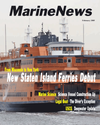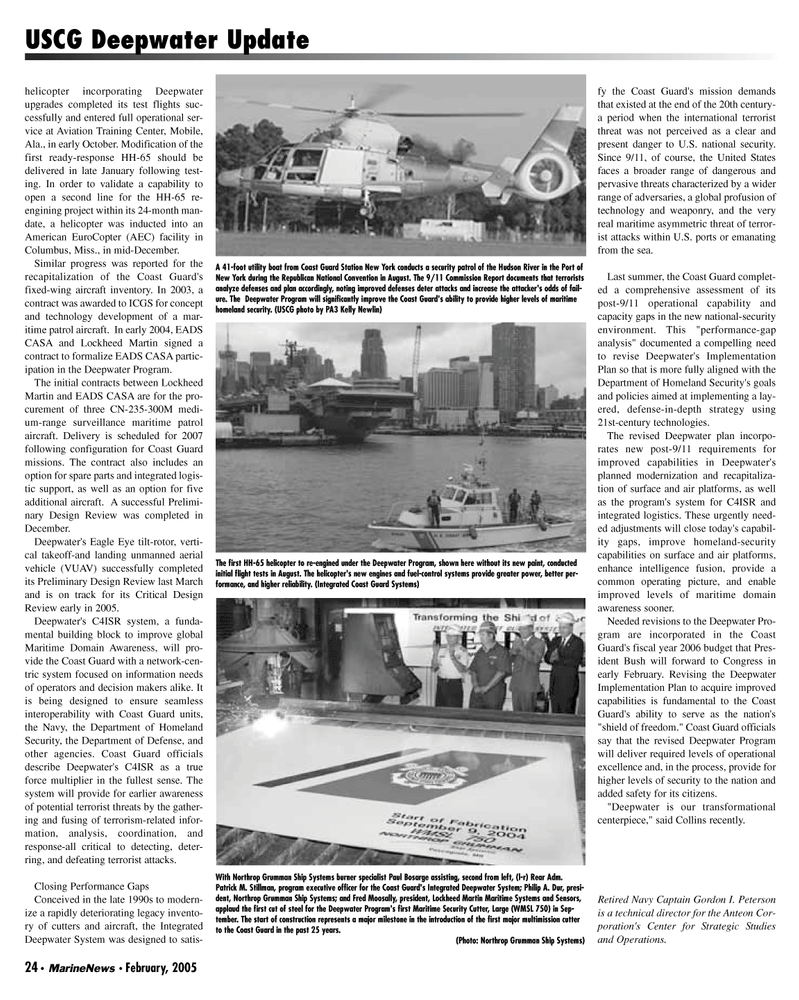
Page 24: of Marine News Magazine (February 2005)
Read this page in Pdf, Flash or Html5 edition of February 2005 Marine News Magazine
helicopter incorporating Deepwater upgrades completed its test flights suc- cessfully and entered full operational ser- vice at Aviation Training Center, Mobile,
Ala., in early October. Modification of the first ready-response HH-65 should be delivered in late January following test- ing. In order to validate a capability to open a second line for the HH-65 re- engining project within its 24-month man- date, a helicopter was inducted into an
American EuroCopter (AEC) facility in
Columbus, Miss., in mid-December.
Similar progress was reported for the recapitalization of the Coast Guard's fixed-wing aircraft inventory. In 2003, a contract was awarded to ICGS for concept and technology development of a mar- itime patrol aircraft. In early 2004, EADS
CASA and Lockheed Martin signed a contract to formalize EADS CASA partic- ipation in the Deepwater Program.
The initial contracts between Lockheed
Martin and EADS CASA are for the pro- curement of three CN-235-300M medi- um-range surveillance maritime patrol aircraft. Delivery is scheduled for 2007 following configuration for Coast Guard missions. The contract also includes an option for spare parts and integrated logis- tic support, as well as an option for five additional aircraft. A successful Prelimi- nary Design Review was completed in
December.
Deepwater's Eagle Eye tilt-rotor, verti- cal takeoff-and landing unmanned aerial vehicle (VUAV) successfully completed its Preliminary Design Review last March and is on track for its Critical Design
Review early in 2005.
Deepwater's C4ISR system, a funda- mental building block to improve global
Maritime Domain Awareness, will pro- vide the Coast Guard with a network-cen- tric system focused on information needs of operators and decision makers alike. It is being designed to ensure seamless interoperability with Coast Guard units, the Navy, the Department of Homeland
Security, the Department of Defense, and other agencies. Coast Guard officials describe Deepwater's C4ISR as a true force multiplier in the fullest sense. The system will provide for earlier awareness of potential terrorist threats by the gather- ing and fusing of terrorism-related infor- mation, analysis, coordination, and response-all critical to detecting, deter- ring, and defeating terrorist attacks.
Closing Performance Gaps
Conceived in the late 1990s to modern- ize a rapidly deteriorating legacy invento- ry of cutters and aircraft, the Integrated
Deepwater System was designed to satis- fy the Coast Guard's mission demands that existed at the end of the 20th century- a period when the international terrorist threat was not perceived as a clear and present danger to U.S. national security.
Since 9/11, of course, the United States faces a broader range of dangerous and pervasive threats characterized by a wider range of adversaries, a global profusion of technology and weaponry, and the very real maritime asymmetric threat of terror- ist attacks within U.S. ports or emanating from the sea.
Last summer, the Coast Guard complet- ed a comprehensive assessment of its post-9/11 operational capability and capacity gaps in the new national-security environment. This "performance-gap analysis" documented a compelling need to revise Deepwater's Implementation
Plan so that is more fully aligned with the
Department of Homeland Security's goals and policies aimed at implementing a lay- ered, defense-in-depth strategy using 21st-century technologies.
The revised Deepwater plan incorpo- rates new post-9/11 requirements for improved capabilities in Deepwater's planned modernization and recapitaliza- tion of surface and air platforms, as well as the program's system for C4ISR and integrated logistics. These urgently need- ed adjustments will close today's capabil- ity gaps, improve homeland-security capabilities on surface and air platforms, enhance intelligence fusion, provide a common operating picture, and enable improved levels of maritime domain awareness sooner.
Needed revisions to the Deepwater Pro- gram are incorporated in the Coast
Guard's fiscal year 2006 budget that Pres- ident Bush will forward to Congress in early February. Revising the Deepwater
Implementation Plan to acquire improved capabilities is fundamental to the Coast
Guard's ability to serve as the nation's "shield of freedom." Coast Guard officials say that the revised Deepwater Program will deliver required levels of operational excellence and, in the process, provide for higher levels of security to the nation and added safety for its citizens. "Deepwater is our transformational centerpiece," said Collins recently.
Retired Navy Captain Gordon I. Peterson is a technical director for the Anteon Cor- poration's Center for Strategic Studies and Operations. 24 • MarineNews • February, 2005
USCG Deepwater Update
A 41-foot utility boat from Coast Guard Station New York conducts a security patrol of the Hudson River in the Port of
New York during the Republican National Convention in August. The 9/11 Commission Report documents that terrorists analyze defenses and plan accordingly, noting improved defenses deter attacks and increase the attacker's odds of fail- ure. The Deepwater Program will significantly improve the Coast Guard's ability to provide higher levels of maritime homeland security. (USCG photo by PA3 Kelly Newlin)
With Northrop Grumman Ship Systems burner specialist Paul Bosarge assisting, second from left, (l-r) Rear Adm.
Patrick M. Stillman, program executive officer for the Coast Guard's Integrated Deepwater System; Philip A. Dur, presi- dent, Northrop Grumman Ship Systems; and Fred Moosally, president, Lockheed Martin Maritime Systems and Sensors, applaud the first cut of steel for the Deepwater Program's first Maritime Security Cutter, Large (WMSL 750) in Sep- tember. The start of construction represents a major milestone in the introduction of the first major multimission cutter to the Coast Guard in the past 25 years. (Photo: Northrop Grumman Ship Systems)
The first HH-65 helicopter to re-engined under the Deepwater Program, shown here without its new paint, conducted initial flight tests in August. The helicopter's new engines and fuel-control systems provide greater power, better per- formance, and higher reliability. (Integrated Coast Guard Systems)
MN FEB05 (17-24).qxd 1/26/2005 4:34 PM Page 24

 23
23

 25
25
